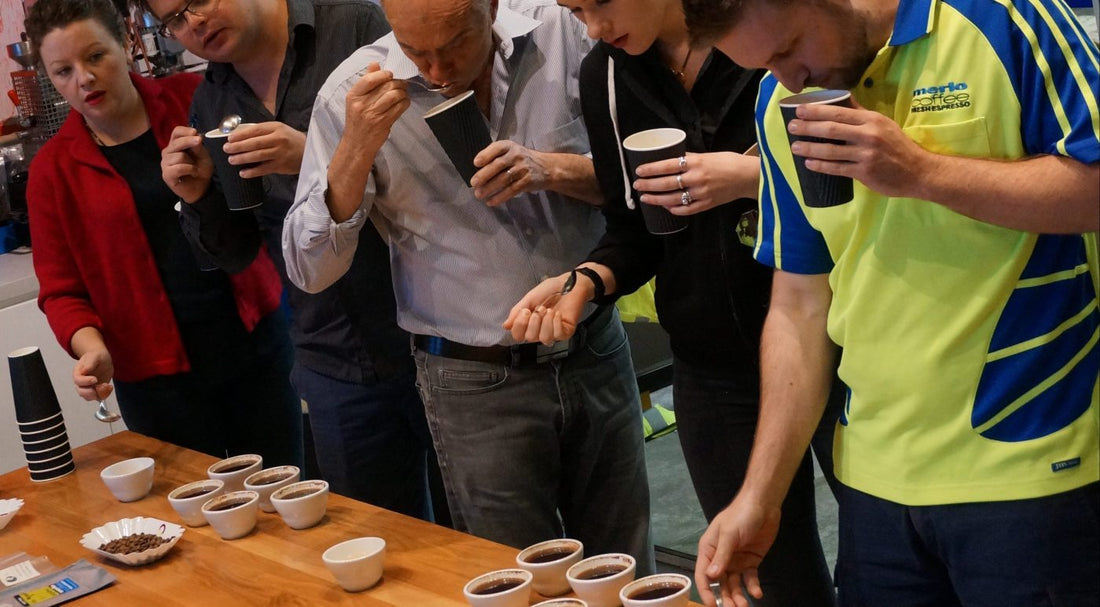Coffee blending is an important facet of any roaster’s job, but what does it take to make a blend?
A coffee blend is quite simply a combination of two or more coffees from individual countries or regions, mixed together according to a recipe.
The ambition of blending is to create a coffee which is greater than the sum of its parts. By mixing different coffees the roaster is able to create something which is well-rounded, utilising the best characteristics of each bean, while covering for any individual deficiencies.
Blending isn’t easy, but it’s definitely effective, both in creating a balanced coffee which ticks all the boxes and in riding out the natural peaks and troughs which are part and parcel of working with any crop. The Colombian coffee you loved so much last year may have been affected by drought, disease or just not quite up to scratch. As with wine, there are good and bad years for coffee harvests, but without the option of cellaring to see if it improves.
In a blend coffees work as an ensemble, each with a role to play. The roaster will write a quick sketch of the ideal they’re working to achieve: for Merlo’s first blend, Private, the aim was to create a rich, full-bodied, smooth blend that would work well with milk-based coffees like lattes and flat whites. Espresso was designed to be traditional, Italian-style coffee, full of rich chocolate flavours, while Riviera aims for caramel sweetness in the finish.

This framework is often determined by the reason for creating a new blend in the first place. Merlo have created blends as a result of talking to customers who let us know they’re wanting something different, whether it’s a request for a milder coffee like Arriba Arriba or a big, strong, bold blend like Forza.
Sometimes the brief will be rooted in social and environmental concerns, and so include logistical parameters, like Organico, which is blended from organically grown beans, processed and shipped.
In between the idea and the finished product is a great deal of work, most of which is undertaken by the Chief Roaster, Steve Olorenshaw.
Using his knowledge of the characteristics of coffee from different areas, Steve will put in requests to suppliers. He will ask for fruity-floral-sweet coffees from Ethiopia or beans from Brazil with smooth walnut and hazelnut flavours and lots of body.
Each note in the brief is a role that needs casting, and the audition process can be long and arduous.

Each candidate for the blend is assessed by the Cupping Panel which meets at least once a week to carry out quality assurance tasting for all existing coffees in stock, choose the Bean of the Month and sample potential new blends.
Before being added to the mix, each individual coffee must be up to standard: clean, sweet, uniform and free of any faults. Simon Brooks, our Head of Operations is a certified Q-Grader who brings his training in quality assessment to each cupping session, alongside Peter Scudamore-Smith, Master of Wine, and members of the Roasting and Training teams. Once the beans have passed muster, the experimentation with recipes and proportions begins.
One of the important decisions which needs to be made is whether the coffee will be blended together before or after the coffee is roasted. Pre-roast blending means that the coffees interact during the roasting process, and the flavours combine. It’s a bit like cooking pasta sauce – the end product doesn’t taste of onion, garlic, olive oil or tomato, but rather a big flavoursome combination of them all.
Post-roast blending means the roaster can ensure each type of bean is roasted perfectly to the level that best suits its density, size and moisture level, and allows each one to shine individually. If pre-roast is pasta sauce, post-roast is a salad – there’s cucumber, lettuce and an olive all together on the fork, but each flavour is still distinct.
Both have advantages and drawbacks and the decision is always made with regard to what will give the best result with the greatest consistency.

Blend prototypes are made up and roasted, with varying degrees of success. Just like with cooking, winemaking or mixing cocktails, sometimes flavours and aromas you think are going to be tasty together just aren’t.
During the process for Alto, which had the flavour brief of sweet fruit and syrup flavours with earthy richness, there was one particular batch which instead had the highly pungent aroma of a compost bin. Needless to say, it did not make it through to the next round of tastings.
Once the general flavours have been achieved, it’s a process of refinement. Small changes in roast levels and adjustments in proportion can add the right level of polish to a blend, bringing out the best characteristics of each ingredient and combining to create something that’s harmonious and balanced. It can be a little like Goldilocks in the end stages – too sharp, too soft, too heavy, too thin – until the whole panel is able to agree that it’s ready to go to the public.
Blends evolve and develop their own character during the process and sometimes end up being something slightly different to what was initially imagined, but the important thing is to make sure the blend is distinctive, brings something new to the table and above all else, tastes delicious.


